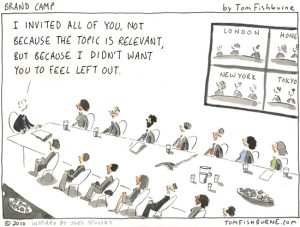Meetings, convenings and taskforces…oh my! As a government employee, brainstorming sessions to solve a specific problem or manage a specific process are likely a big part of your daily life. If that’s true, congrats! It means you’re a great government employee who prioritizes listening to lots of opinions and finding the right way to do something. But also, if that’s true, our sincerest sympathies. Because that means you’ve probably sat through a whole slew of ad hoc brainstorming sessions where you walked out asking, “What just happened?”
Brainstorming sessions that are not well planned and executed are a waste of everyone’s time. And nobody wants to be the person who wastes colleagues’ time. Our team has been thinking about meeting facilitation lately because just yesterday, we led a brainstorming session for a partner city in New Jersey. We had to help them choose an idea to submit as well as a strategy for securing philanthropic funding.
So here you go, our two-part guide to running an effective brainstorming session in government.
Before the meeting…
Think of the End at the Beginning
Your first step should always be thinking of the outcomes you desire. What do you want participants to leave the session with? Be specific. Is it a list of ideas to solve a particular problem (e.g. ideas to increase communication across departments)? Is it a plan (e.g. the best way to announce a new permitting process)? Explicitly include the objective in your session invitations – this can be casual and communicated verbally, via email or in the calendar invite. Regardless of how the message is delivered, being clear about the objectives of the meeting will ensure everyone enters with the same purpose.
Invite the Right People

To get the best ideas, diversity of participants is key. Diversity can mean different things depending on the context, but try to find diversity of role, seniority, experience, education, departments or agencies. Cast a wide net (at first).
When making your target invitee list, ask yourself:
- Who is else is affected by the problem we’re trying to solve?
- Who will benefit if the problem is solved?
- What government departments or agencies have authority over solving the problem?
- Are there private sector or non-profit partners who can solve part or all of the problem?
From that list, determine what level of engagement is appropriate at this moment. Is this a topic that should just include your direct team now and you can engage other departments later? Or is it a topic that would benefit from early engagement of a diverse set of internal and external (e.g. nonprofits, citizens groups, think tanks) opinions? Depending on context, inviting external stakeholders to a brainstorming session can be a fantastic way to generate excitement and new ideas during a government-led brainstorming session.
*Warning: Resist the urge to invite everyone (and their mom!) Governments of all levels like to have big tents – that is, they like to encourage participation from as many people as possible. Broad engagement, of course, can lead to greater buy-in, support, and eventually better outcomes. But brainstorming sessions are not necessarily the time or place to get buy-in. We can’t tell you how many federal government interagency groups we have participated in that had brainstorming sessions attended by 50+ people. Size matters. If the group is too large, people won’t feel comfortable sharing ideas.
Set the Scene
For successful idea generation, you must break people out of their day-to-day thinking. You want to signal early on that this meeting will be different. One way to do this is by choosing an offsite location—a coffee shop down the street, your building’s roof or the park across the street. Our team’s best brainstorming and problem solving happens when we’re on a walk outside, for example. Getting people out of the office not only makes the session more casual and fun but it can also help spur more out-of-the-box-thinking.
Timing also matters. While it’s important to carve out enough time for participants not to feel rushed, keeping a good pace will prevent people from checking out. Here’s a lesson in what not to do. My cofounder recently participated in a “brainstorming session” with more than a dozen government officials and staff (not facilitated by us, obviously!) that was more than two hours long and took place on a conference call. Brutal.
*Warning: Beware the boring conference room. This can be a tough one for brainstorming in governments because a lot of governments lack flexibility in choosing meeting locations. But nothing is more creativity sucking than sitting in the same dark conference room where you have all of your routine meetings. If you don’t have an alternative, don’t fret! Small fixes—like bringing snacks or office toys—can help shift people’s mindsets and boost creativity.
Tune in next week to see Part 2 of this series, “How to Run Brainstorming Sessions in Government.”
Elle Hempen is part of the GovLoop Featured Blogger program, where we feature blog posts by government voices from all across the country (and world!). To see more Featured Blogger posts, click here.





Leave a Reply
You must be logged in to post a comment.